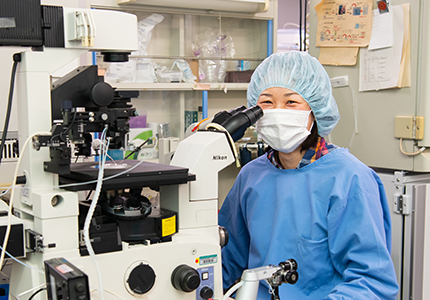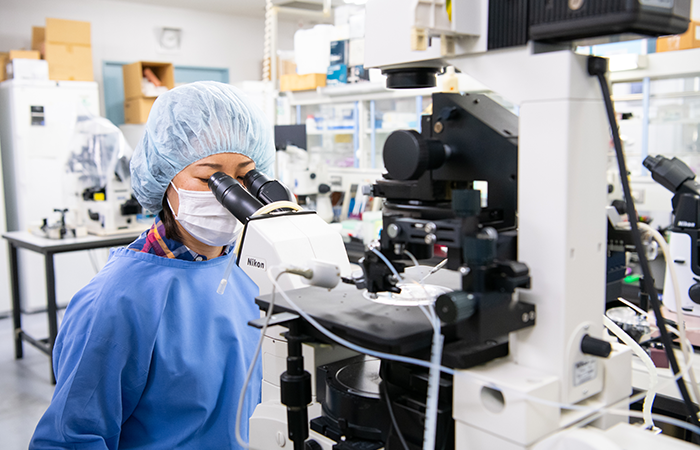Developing Novel Animal Models Using Advanced Technology
Supporting World’s-first Research
BRC is supported by a diverse staff who are involved in a variety of tasks. We have interviewed staff members from each of the 12 laboratories that make up BRC, asking them about their activities and their day-to-day efforts in their research rooms.
This time, we are speaking with Michiko Hirose, who works in a Technical Staff II position in the Bioresource Engineering Division.
We asked her, who is supporting world-first research through the creation of acrosin (*1) knockout (*2) hamsters and is dedicated to pursuing new developments in the division, about what she considers to be the most essential, difficult, and enjoyable aspects of her work.
The path toward genome-edited animal production
Struggling in front of the microscope
The Bioresource Engineering Division develops the various genetic technologies necessary to maintain and supply bioresources (experimental animals and stem cells) at a high level of quality based on four pillars of development, namely SCNT (Somatic Cell Nuclear Transfer cloning technology), intracytoplasmic sperm injection, embryo and sperm cryopreservation, and new stem cell and novel animal model development. In addition, we conduct research on reproduction using these technologies.
Of these four research themes, I am in charge of the development of new stem cells and novel animal models. Currently, as part of my work on developing novel animal models I am working with hamsters on the creation of genome-edited animals using the CRISPR/Cas9 system (*3).
Before working at RIKEN, I started my career as a technical staff in charge of generation transgenic mice (*4) and chimeric mice (*5) when I was employed at the University of Tsukuba, Laboratory Animal Resource Center.
After that, I joined RIKEN BRC in 2004 through an introduction from my former boss, but I had a really hard time when I first came to work here. I had been operating a microscope at my previous job, so I thought it was natural that I could do it, but the images I saw here were completely different from those I saw through the microscopes I had used before, and it was difficult for me to get a sense of how to make out details. I couldn’t get the hang of injecting DNA through a needle into the nuclear membranes inside the zygote no matter how many times I tried. Photographs of the work in progress are easy to understand because they have a flat surface that shows a bird’s-eye view, but the actual work is done on a three-dimensional object, so if the needle is even slightly displaced, it will not penetrate at all. At first, no matter how hard I tried, the needle wouldn’t go in, the embryo would die, and so on, which made me feel quite depressed.

Cloned embryo production requires steady and diligent work day after day
The basic principles are "intensively" and "for a short period"
This job often requires the adopting the same posture and repeating the same movements for long periods of time, so it may not be suitable for everybody. Somatic Cell Nuclear Transfer, the process of creating cloned embryos, is a lengthy task that takes two or three hours. During that time, you may be sitting and injecting the whole time, so the first thing is to be able to endure it.
Also, although it is something that you will definitely get used to if you do it enough times, at the beginning, no matter how many times you try, the ovum will die, the needle will clog, and the work will not go very well.
To get the hang of it, the basic rule is to do it intensively over a short period. For example, rather than doing the same thing once a week for six months or a year, you will improve more effectively if do the same thing every day for a month. I think what is needed in this job is perseverance, or the ability to remain patient.
Everything is a detour that leads to a good result
A World’s-first study realized with hamsters
You may find yourself more interested and intrigued by the researchers around you than by what could be called “interesting” about your own work.
I would like to share a quotation from a former research colleague of mine that influenced, or rather shocked me. He said, “I believe that everything is a detour that leads to a good result.” He was saying this in a situation where we had an experiment that was not going well at all. He was a positive thinker by nature, and I remember clearly how his words encouraged me very much.
I was also impressed by the director’s foresight about and enthusiasm for hamsters. In our division, we work with hamsters, and this can be quite difficult. Hamsters have a very long history as experimental animals, and the first successful cases of in vitro fertilization (IVF) were not in mice but in hamsters. But with hamsters, even if IVF is successful, it is very difficult to produce offspring.
In fact, despite the initial success of IVF, the first birth of a hamster produced by IVF did not occur until about 30 years later. This was because in the case of hamsters, embryos are very difficult to culture in vitro, and if conditions such as CO2 concentration, temperature, light, and chemicals are even slightly mismatched, embryo development will not be able to proceed.
RIKEN BRC has Experimental Animal Division which provides laboratory mice. However, for many years, my laboratory has focused not only on mice but also on hamster resources, which are very difficult to handle.There are many genes for which no phenotypes (observable traits) are produced even if these genes are knocked out in mice, but there is a good chance that working with different species of animals will produce different results. The laboratory director thought that this could be achieved by using hamsters.
The research published in January 2020 that led to the identification (*6) of a sperm-derived enzyme essential for fertilization in mammalian species was the result of the director’s efforts. This study, which revealed that acrosin, the major protease of mammalian spermatozoa, is essential for the passage of sperm through the zona pellucida during fertilization, has put hamsters under the spotlight as experimental animals.
Currently, I am attempting to freeze and thaw male and female hamster gametes, for which cryo-preservation has not been successful up to now due to the unique characteristics of these particular embryos. My main goals are to successfully freeze and thaw both male and female gametes and to advance the phylogenetic conservation of the genome-edited hamster lines we have created so far. Beyond that, I would like to continue working on the development of new technologies together with the people around me, including my fellow researchers who continue to conduct unprecedented research and experimental trials.

- *1. Acrosin: A sperm protease; an enzyme that catalyzes proteolysis
- *2. Knockout organisms: Organisms that have been genetically modified by inactivating or “knocking out” certain existing genes
- *3. CRISPR/Cas9 system: A highly accurate technology that can precisely cut out a targeted portion of an organism’s genetic information, called a genome, or incorporate other genetic information
- *4. Transgenic mice: Mice that have been artificially transfected with foreign genes
- *5. Chimeric mice: Mice containing cells derived from two distinct mouse strains and created by transplanting ES cells or other pluripotent stem cells into early embryos
- *6. Identification: A general scientific term for finding out what something is about an object
Profile
- Michiko Hirose
- Technical Staff II, Bioresource Engineering Division
- After working as a member of the technical staff at the Laboratory Animal Resource Center at the University of Tsukuba, she joined the Bioresource Engineering Division at RIKEN BRC in 2004. She is currently involved in the establishment of new stem cell lines and the development of new animal models, etc.
Release date : July 26, 2024
